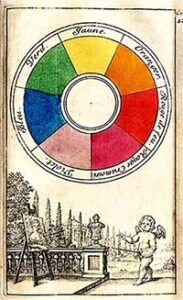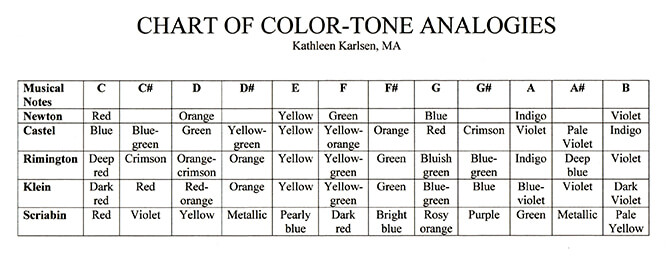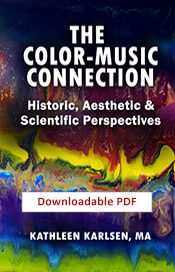
The Power of Color & Music
The power of color and music to inspire, comfort, and motivate is widely recognized. The more mysterious powers of music and color include the ability to heal the body and mind. Modern research is proving this idea. In our world of constant multimedia stimulation, this has become a fertile field for ongoing research and practical applications.
Share this page with a friend!
Ancient Roots of Color Music
History indicates that combinations of color, sound, and motion have always fascinated people. Virtually every culture has some form of traditional dance that combines colorful costumes, rhythmic music, and whirling, energetic dance steps.
Influence of Color and Music
From the days of the ancient Greeks through the Middle Ages and into the Renaissance, both color and music were widely considered to possess inherent moral powers. Music and color were thought to influence viewers and listeners for better or for worse.
Combining Music and Color
Even in contemporary times, mystics and followers of occult traditions have insisted that particular colors and types of music possess the ability to induce trances, hypnotic states and healing. This is especially true of synchronized combinations of the two art forms. The history of music and color is essentially the history of multimedia.
History of Color Music Combinations
The history of color music in various cultures extends around the world. In the Middle Ages, magicians and entertainers mesmerized their audiences with a variety of devices that used firelight to project shadows against walls. The desire to unify the arts has been a driving force and the ultimate goal of many creative artists for ages.
Color Music Synchronization
There are numerous theories, creative works, and scientific studies related to the phenomenon of color music synchronization. The attempt to determine whether a direct analogy exists between the arts of color and music began in antiquity and continues today.

Aristotle and Plato
Photo Courtesy of Wikimedia Commons
Painting by Raphael (1483-1520), Public Domain
Color Music and the Greeks
Similarities between color and music were clearly noted by the ancient Greeks. Some Greek theorists considered “color” to be synonymous with “timbre” as a quality of sound. In the fourth century BC, Plato’s friend Archytas of Tarentum called a new kind of musical scale “chromatic.” Chromatic means both notes in a musical scale and something produced by color. Since the days of the Greeks, color and music have shared a common nomenclature: tone, pitch, intensity, volume, form, etc.
Color Music Analogies
The analogous aspects of color and music that seems to have been the most convincing to the Greeks included the similarity in their regularly stepped scales. In other words, both color and sound can be arranged in a series of stages with equal differences between each measured step. The ratios among gradations of colors is similar to musical ratios and proportions.
Aristotle and Color Music
In his book De Sensu, Aristotle discussed a possible analogy between color and sound harmonies. Although Plato himself eschewed any attempt to correlate colors and sound, Aristotle wrote briefly of the potential success of this endeavor in his treatise entitled On Sense and Sensible Objects.
Color Music Scales
For example, Aristotle agreed with the early Greek theorists that purple could be identified with the musical fifth, red with the fourth and white with the octave, but he seems to hesitate to construct a complete color scale in direct relationship to the musical scale. Pythagoras also contemplated a parallel between the musical scale and the spectral colors.
Claude Boutet’s 1708 Color Wheel
Based on Isaac Newton’s Theory of Colors
Courtesy of Wikimedia Commons, Public Domain
Color Music in the Middle Ages
Throughout the Middle Ages and the Renaissance, a variety of musicians and artists envisioned an art form that would combine color and music. Rudolph of St. Trond, a theorist of the late eleventh century, claimed that the modes of plainsong could be identified with the ancient Greek modes and that both could be allied with particular colors.
Connecting Colors to Musical Scales
In his notational system, the Dorian mode was to be written in red, the Phrygian mode in green, the Lydian mode in yellow and the Mixolydian in purple. The Milanese theorist Franchino Gaffurio reintroduced this idea in the fifteenth century. Gaffurio further associated the colors and modes with the Greek humors.
Colors and Musical Chords
Vincent of Beauvais, the medieval author of a work called Great Mirror, attempted to expound upon Aristotle’s original proportional color music ratios. However, Beauvais believed that only seven colors could embody proportions that would appear pleasant to the eye. This resulted in a different color-chord consonance. Beauvais related pink to the musical fifth and light green to the musical fourth.
Color Music in the Renaissance
During the Renaissance, the Venetian theorist Gioseffo Zarlino claimed that modern musical counterpoint had added the major and minor thirds and the major sixth to the ancient fundamental ratios of the fourth, fifth and octave. Musical consonance was thus brought directly into a potential relationship with a scale of primary and secondary colors.
Merging Visual Art and Music
Arcimboldo, a Milanese painter of the sixteenth century, was one of the earliest artists in a long line of luminaries to endeavor to merge the arts of painting and music. Arcimboldo devised a method of color harmony upon a color scale similar to the musical scale. These early roots of multimedia led to ongoing attempts by artists and musicians to create the combinations of color and music that we know today as multimedia art.
Color Music in the Age of Enlightenment
The pivotal scientist Isaac Newton put forth a set of color music correspondences in his famous foundational book Optiks, originally published in 1730. In this work, Newton related the spectral colors to the diatonic scale in a simple, straight-forward approach: red was equivalent to the note C, orange was paired with the note D, yellow was matched with the note E, green was associated with the note F and so forth.
Isaac Newton and J.W. Von Goethe
On the other hand, the German poet and philosopher J.W. von Goethe’s famous three-part publication Theory of Colors (1810) attacked much of Newton’s color theories. Goethe did not believe that color and music could be compared in any way.
Goethe and the Psychology of Vision
However, Goethe did emphasize the psychology of vision and the allegorical and symbolic values of color. These conflicting ideas set the stage for modem artists and musicians to interpret the color music connection according to their own temperaments, scientific leanings, and aesthetic sensitivities.
Synesthesia, Music, and Color
The word “synesthesia” is derived from the Greek words “syn,” which means “together,” and “aisthesis,” which means “perception.” Synesthesia refers to individuals who experience involuntary cross-sensory associations. The most common form of synesthesia is “colored hearing,” or seeing colors when a sound is heard. Interestingly, Pythagoras considered synesthesia to be the greatest philosophical gift and spiritual achievement.
Studies of Synesthesia
Synesthesia has been studied repeatedly over the course of the last hundred years. The term has been used to describe a confusing array of sensory and symbolic associative “disorders.” In order to clarify the exact phenomena under study, Dr. Richard Cytowic has proposed criteria for a definitive diagnosis of the condition. True synesthesia is involuntary, stable over the individual’s lifetime, memorable, contains an emotional component, and is marked by discreet perceptions.
Synesthetes as Artists
Although synesthetes may be no more divine than the rest of us, a December 1999 article in Discover magazine reported that “cognitive scientists contend that these unusual people are precious windows into the ultimate mystery of human consciousness.” Mystical synesthetes in the fields of the arts including Alexander Scriabin (composer, 1872-1915) and Wassily Kandinsky (artist, 1866-1944) probably would have agreed!
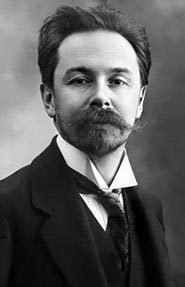
Alexander Scriabin, Russian Composer and Musician
Historical Photo Courtesy of Wikimedia Commons, Public Domain
Scientific Explanations of Synesthesia
Current scientific explanations of synesthesia are built on the hypothesis that “early in infancy, probably up to about 4 months of age, all human babies experience sensory input in an undifferentiated way” (Andrew David Lyons, Evaluating New Tools and Techniques for Intermedia Composition and Production, Sydney Conservatorium of Music, July 2000).
Synesthesia as Highly Individual
Adult synesthesia may be a lack of the modularization between the senses that normally develops. An intriguing aspect of synesthesia is the fact that the phenomenon is highly individual. Although there appears to be a genetic link in the occurrence of synesthesia, even synesthetes in the same family associate different colors with different sounds.
Connecting Colors and Alphabet Letters
For example, one synesthete studied saw the color white in connection with hearing the vowel sound ‘A,’ whereas one of his daughters saw the color blue linked to ‘A,’ and another daughter saw the color black (Faber Birren, Color Psychology and Color Therapy).
Color and Music in Health and Psychology
There are multiple practical applications of color and music combinations. For example, moving patterns of color and form have been used in a British hospital to reduce the pain medication needed by woman during childbirth. Britain’s John Healey created moving geometric light abstractions with lenses and mirrors. Healey’s work was covered in an April 28, 1967 issue of Time magazine. In addition, nature films accompanied by music are gaining widespread acceptance in hospitals as a soothing alternative to traditional TV programming for patients.
Color Music in Therapeutic Psychology
Color music has also been used by psychologists as a type of moving Rorshach test. Another significant use of color music took place with post-WWII veterans suffering from depression and post-traumatic shock. The patients were shown color music movies, known as Aurotone films. See below for an example and further information about Auroratone Films.

More extreme examples of the phenomenon of the power of color and sound are the flashing lights in modern discos and bars. At the height of the disco era, dancers were known to pass out due to sensory overload. Psychologists also believe that the sensory overload caused by the combination of loud, rhythmic music and strobe lights reduces interpersonal inhibitions.
Epilepsy Triggered by Flashing Lights
Recent studies of epilepsy actually concur that some types of seizures can be triggered by the color and sound patterns of video games and animated cartoons. In a world filled with multimedia, an examination of the possible association between color and music has become increasingly significant.
Auroratone Color Music Films
In the 1940s, a British filmmaker named Cecil Stokes created a series of therapeutic films that were used in psychiatric hospitals. At the time, there was an influx of soldiers from WWII who were suffering from a variety of mental disorders. Some had PTSD, others were suicidal, and others were unable to adjust to life with the disabilities they suffered from as a result of the war. Motion film itself was relatively new and had a big impact on the viewer.
Patterns in Auroratone Films
The Auroratone films consisted of changing abstract forms in pastel colors set to organ music, sometimes accompanied by the singing of Bing Crosby. One recording includes organ music and Bing Crosby’s rendition of “When the Organ Played Oh Promise Me”. The song is a reminiscent song about the days when the singer met his love and the years that have gone by and how sweet she still is to him.
Creating and Preserving Auroratone Films
Apparently there was originally a set of at least four Auroratone Films. These films consisted of shifting, abstract shapes created using crystallized chemicals and polarized light. The one surviving film was recently restored by Robert Martens, whose grandfather worked in a psychiatric hospital where the film was used.
Usefulness of Auroratone Films
Auroratone Films were used in psychiatric hospitals in New York and New Jersey. However, no one seems to know if the follow-up counseling for the patients directly referenced the films or not. Many patients viewing the color-music films were so moved emotionally that they became more accessible for traditional group and individual therapeutic methods.
The Pokemon Shock Phenomenon
In addition to the use of color and music in health care, combinations of music and color can also have damaging affects. On December 16, 1997, an episode of Pokemon was broadcast in Japan and watched by an estimated four million children. The impact of the cartoon sent almost 700 kids to the emergency room. This unintentionally demonstrated the powerful effects on the brain of certain sequences of color and sound. The episode was called Electric Soldier Porygon. What resulted was called Pokemon Shock.
Trigger of Strobe Lights
In this particular episode, Ash and his his friends travel inside a broken Pokemon transmitter machine and try to fix it. About twenty minutes into the program, Pikachu uses his lightening attack to blow up some virtual missiles. Rapidly strobing red and blue lights accompany the explosion.
Deleterious Impact on Children
Children across Japan passed out, got dizzy, had blurred vision, felt nauseous or even experienced seizures. Ambulances took 375 girls and 310 boys to the hospital. Most recovered quickly but a small number were diagnosed with epilepsy triggered by the strobe lights in the program.
Banning the Electric Soldier Episode
Not only was this a disaster for the affected children, but Nintendo took a huge hit as well. Stocks fell as the show was taken off the air for nearly four months while health experts sought to understand what had happened. The Electric Soldier Porygon episode was banned worldwide.
Dangers of Strobe Lights in Video Games
When the show returned, the first episode was preceded by an explanation of what had happened and reassurances that this incident could not and would not happen again. The strobe lighting technique was abandoned to protect anyone with vulnerability towards photosensitive seizures. Nintendo and other companies added warnings on video games of the this danger.
Strobe Lights in Discos
A similar phenomenon was noted during the heyday of disco. On occasion a dancer would go into seizure under the flashing lights and pounding music of the era. Seizures can also be triggered by other less structured sources.
Photosensitive Epilepsy
For example, driving by a fence with the sun shining through the slats can create a strobe effect that has been known to cause seizures. Although you can’t protect against all potential triggers for photosensitive epilepsy, Pokemon Shock dramatically increased awareness of the power of multimedia and the impact of color and sound on the brain.
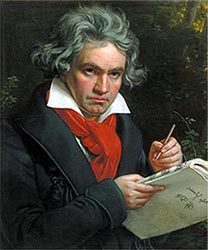
Ludwig van Beethoven, Portrait by Karl Joseph Stieler
Image Courtesy of Wikimedia Commons, Public Domain
Classical Composers and Color Music
A number of classical and modern composers have believed in a direct correlation between notes of the musical scale and colors. Classical and modern composers fond of relating colors to their music include Liszt, Beethoven, Schubert and Rimsky-Korsakoff. Liszt described his dramatic intentions for his music with decorative phrases: “More pink here,” “This is too black,” “I want it all azure.”
Beethoven and Color Music
Beethoven is reported to have referred to B minor as the black key. Schubert is said to have compared the E minor key to “a maiden robed in white and with a rose-red bow on her breast”. And Rimsky-Korsakoff associated the color of sunlight with C major and strawberry red with the note F sharp.
Color Music Instruments
Color music is a specific type of multimedia artistic composition that consists of mobile abstract or geometric shapes integrated with music. Over the course of the development of modern motion graphics, color music has also been referred to as kinetic art and lumia. Historically, the experiences of color and music have always been closely intertwined.
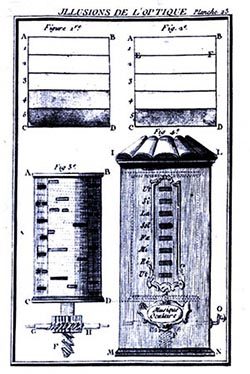
Diagrams Showing Color Music Correspondences (1770)
Image Courtesy of Wikimedia Commons, Public Domain
Leonardo and Color Music Instruments
Leonardo da Vinci (1452-1519), who insisted on rational and geometric arguments for the color music connection, was sufficiently convinced of the consonances between color and music to draw diagrams of instruments called color organs. Other inventors also created a variety of instruments in which movement was simulated by “wheels spinning in front of a light, revolving discs, … and innumerable crude … devices that created a variety of visual effects” (Lee R. Bobker, The New Art: A Critical Anthology, 1973).
Designing Color Music Instruments
Athanasius Kircher designed an early projecting instrument in 1648. He proposed the utilization of candlelight and colored glass lenses, but his instrument was never built. The first visual music instrument that was actually built was the creation of a French Jesuit priest, Louis-Bertrand Castel. The number of color organs and visual music instruments invented in the first half of the 20th century is legion: the Clavilux, the Sarabet, the Light Console, the Clavier a Lumieres, the Colortron, Chromaton, Celeston, and the Sculptachrome are among the more well known.
The Amazing Ocular Harpsichord
Louis-Bertrand Castel (1688-1757) was a mathematician and writer with an interest in aesthetics. In 1730, he built a musical instrument that combined sound with prisms intended to cast colored light. Castel began by placing a square frame above a standard harpsichord. This frame supported sixty small windows of different colored glass panes.
Color and Music in the Ocular Harpsichord
Small curtains were attached by pullies in front of each pane. Candles burned behind each curtain to give light. When a key was struck, the associated curtain would lift to reveal the corresponding color. According to William Moritz, a professor of film and animation history and author of the Animation World Magazine article entitled “The Dream of Color Music and the Machines That Made It Possible,” the ocular harpsichord was a phenomena in its day:
“Enlightenment society was dazzled and fascinated by this invention, and flocked to [Castel’s] Paris studio for demonstrations. The German composer Telemann traveled to France to see it, composed some pieces to be played on the Ocular Harpsichord, and wrote a German-language book about it.”
Creating an Improved Color Music Organ
Castel later went on to create a second, improved model with greater projecting power for the benefit of larger audience. This new model, built in 1754, used about five hundred candles with reflecting mirrors to provide greater light to shine through the colored glass.
Color-for-Note Correspondence
Castel’s approach was clearly a color-for-note correspondence, but how he arrived at his choice of colors is unclear. The instrument was clumsy and there was “considerable chance of noise and malfunction between the pullies, curtains and candles” (Moritz).
Fate of the Ocular Harpsichord
However, Castel believed that the Ocular Harpsichord would one day be mass-produced. He envisioned his instrument in the parlor of every home in Paris, but Castel’s dream was not to be fulfilled. Real progress had to await the invention of electricity.
Color Music Instruments Using Electricity
Each of the many color music instruments created after the invention of electricity was unique. Dozens of devoted artists and musicians dedicated virtually endless hours and years to perfecting their instruments and compositions.
Inventing Visual Music
Indeed, a number of creative artists and inventors made the development of this new visual music the focus of their life’s work. This level of commitment underscores their fundamental conviction that a color-music connection not only exists, but that the conscious unification of color and sound is a viable and important dramatic artform.
Variations in Visual Music Instruments
- Some visual music instruments created geometric, angular forms.
- Some visual music instruments produced soft, flowing images.
- Some instruments linked certain colors directly with particular tones.
- Other instruments aimed at generating colorful atmospheres that loosely interpreted associated music.
- Some visual music instruments created moving color shapes analogous to music, but were not accompanied by sound.
- A few of these visual music instruments produced representational images.
Color Music and the Clavilux
Thomas Wilfred named his first successful color music instrument the Clavilux after the Latin terms meaning “light played by key.” This complex instrument was the result of fourteen years of experimentation. The Clavilux included a keyboard, numerous powerful light projectors, condensing lenses, filters and an assortment of discs.
Complexity of Color Music Instruments
The minimum of four projection units was controlled through registers and dials arranged in tiers. Wilfred’s visual music instrument also featured a set of rollers on which the papers containing his vertical system of notation were mounted. The paper moved upward “like the record in a player-piano, disclosing only the passage to be played” (Donna M. Stein, Thomas Wilfred: Lumia, A Retrospective Exhibition).
Inventing the Chronograph
Wilfred called this unique mechanical system, which also included a metronome, the Chronograph. Additional mechanisms related directly to artistic variations in the colored lights were actually developed for the Sarabet, an instrument created by Wilfred’s rival counterpart, Mary Hallock Greenewalt.
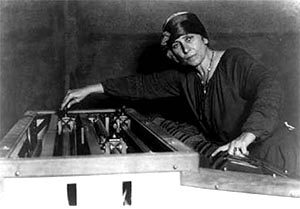
Mary Hallock Greenewalt and the Sarabet Color Organ
Photo Courtesy of Wikimedia Commons, Underwood & Underwood, Public Domain
The Sarabet by Mary Hallock Greenewalt
The color music instrument constructed and patented by Mary Hallock Greenewalt was “capable of giving forth a light scale conforming with a musical scale” (Tom Douglas Jones, The Art of Light and Color, 1972). Greenewalt’s instrument won a gold medal at the Sesqui-Centennial International Exposition at Philadelphia in 1926.
Inventions of Mary Hallock Greenewalt
Greenewalt invented two electrical mechanisms. These were the rheostat and the liquid-mercury switch. These mechanisms allowed her to modulate light smoothly on the Sarabet. A number of other composers (including Thomas Wilfred) began to invent variations of these two switches. Greenewalt tried to sue for patent infringement, but a judge denied her case, ruling that “these electric mechanisms were too complex to have been invented by a woman.”
The Colortron of Tom Douglas Jones
Tom Douglas Jones, the inventor of the Colortron, was a graphic designer, a professor, and a fairly competent engineer. The Colortron began as a teaching device that Jones used to demonstrate the additive color circle of light mixtures to his students at the University of Kansas during the. The Colortron, however, became much more than this.
Color Music Instruments in Education
According to Jones, the Colortron not only solved the immediate teaching problem but proved to be an invaluable tool for experimentation and for demonstration of colored shadows, afterimage, simultaneous contrast, irradiation, color constancy, and many other phenomena of light and color.
Recreating Color Music Compositions
Rather than a keyboard, Jones used a series of switches and dimmers that were calibrated so that he could record the settings. In this way, he could recreate particular compositions at will. Jones also experimented with illuminating silhouettes of sculptured forms and with colored lights through mobile metal stencil plates.
Creating a Kaleidoscope of Color
As the discs revolved in front of one another, fluid transitions of form and color were created like a type of kaleidoscope. Sets of discs could be used interchangeably to create a virtually infinite number of patterns. Even the relatively pragmatic Jones had to admit that the Celeston produced “amazing and beautiful results.”
Color Music and Filmmaking
The liquid effects produced by the projector-like Celeston were also characteristic of the compositions of other visual music artists who chose to work in the new medium of film. Early filmmakers in the color music genre used drawings, clay forms, hand painting and more.
Color Music Before Film
With the creation of the Celeston, Tom Douglas Jones demonstrated an increased enthusiasm for uniting the arts of color and music. Although he continued to reject the notion of a concrete link between particular colors and notes of the musical scale, he worked carefully with correspondences of tempo and dynamics.
Synchronizing Volume and Color
Jones matched softness in music with dimness in light. Likewise, he matched loudness with a greater intensity of light. He carefully paired appropriate moving color forms to his chosen musical scores. As Jones himself wrote in The Art of Light and Color: “the Gestalt thus produced was more than the sum of its parts—bringing a new excitement and pleasure to all who saw and heard it; even to those with little feeling for color or music alone.”
Constructing the Celeston
The Celeston was fairly simple in conception as a visual music instrument. A single light bulb shone through two rotating discs on which colored pieces of glass, small prisms, colored beads and colored acetate were mounted.
Patterns of Color from the Celeston
As the discs revolved in front of one another, fluid transitions of form and color were created like a type of kaleidoscope. Sets of discs could be used interchangeably to create a virtually infinite number of patterns. Even the relatively pragmatic Jones had to admit that the Celeston produced “amazing and beautiful results.”
Visual Music Artist Compositions
The liquid effects produced by the projector-like Celeston were also characteristic of the compositions of other visual music artists who chose to work in the new medium of film. Early filmmakers in the visual music genre used drawings, clay forms, hand painting and more.
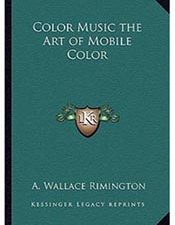
Color Music The Art of Mobile Color (1911)
By Alexander Wallace Rimington
Photo Courtesy of Wikimedia Commons, Public Domain
Rimington: An Early Proponent of Color Music
Alexander Wallace Rimington (1854-1918) was a prominent instrument inventor, writer and artist in the nineteenth and early twentieth centuries. Rimington wrote extensively on the analogy between color and sound in his book Colour-Music: The Art of Mobile Color, published in 1911.
Color-Music Analogies
Rimington, like a number of other theorists, constructed a scale of direct color-music analogies. Most importantly, Rimington set forth and thoroughly discussed what he considered to be the major points of resemblance between color and music. Many of Rimington’s ideas were not new, as these were probably some of the very issues pondered by the Greeks in ancient days as well as by alchemists, mystics and philosophers throughout history.
- Both color and music are produced by vibrations that act upon the eye and ear respectively.
- Both color and music are limited to particular ranges of visible or audible vibrations.
- Both create their effects through changeable levels of harmony and discord.
- Both give pleasure or distress through a variety of combinations and sequences.
- Both color and music can be combined with other art forms for a heightened experience.
- Rhythm can be used to add interest in both artistic and musical compositions.
- Changes in dynamics can be created in color through hue and in music through volume.

Biogeometry and the Pyramid Shape
Biogeometry and the Power of Art
Some of the mysterious power of art involves the science of geometric figures. For example, some writers have gathered evidence suggesting that placing items in pyramids can have almost supernatural results. Food can be preserved without refrigeration and dull knives can miraculously become sharp.
Object Forms and Biogeometry
The new field of biogeometry also suggests that the form of objects is directly related to their ability to help or harm living things. A cell phone, the theory postulates, can be designed so that its physical shape counteracts any potentially damaging radiation. Likewise, homes can be designed to offset the effects of geopathic stress.
Geometry and Spirituality
In the spiritual arena, geometric forms have a long history of use for meditation and for inducing trance-like states. Mandalas and yantras are traditional art forms that are used for spiritual purposes. Some art historians believe that stained glass windows in churches are extremely effective in creating an aura of mystery and majesty for religious ceremonies due to the effects on the human brain of the movement of sunlight through colored glass.
Author Kathleen Karlsen
Kathleen Karlsen is a musician, artist, writer and speaker. She is the author of two books (Flower Symbols and Vocal Medicine) and over 200 articles. Kathleen, her husband Andrew, and their five children live in Bozeman, Montana. More about Kathleen Karlsen.
The Color-Music Connection by Kathleen Karlsen is a comprehensive view of the parallels between sound and color from historic, scientific and aesthetics perspectives. $1.95 PDF, 60 pgs
COLOR MUSIC ARTICLE SUMMARY
Since the days of Aristotle and Pythagoras, philosophers, artists, musicians and scientists have debated whether an analogy exists between color and music. The aesthetic theories and creative works of significant modem artists and musicians reveal the ongoing nature of this debate. Although scientific proof of a direct connection between color and music remains subjective and elusive, the weight of philosophical and historical evidence supports the contention that a connection does exist on an intuitive and aesthetic level.

